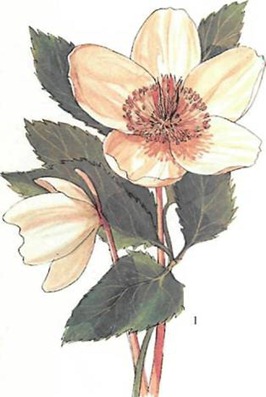





There’s a whole galaxy of colourful plants available today among the herbaceous perennials. The roots you buy may seem small, but month by month, year by year, they grow into clumps of hardy, trouble-free flowers. You can increase them yourself. Having examined our soil a couple of stages back, we now take a closer look at pesticides. Our final contribution to the cottage garden perennial patch is the Christmas rose which we plant 18 in./46 cm. from the colchicums.
Needs list: 3 Christmas rose plants; 16 herbaceous perennials.
Time budget: 5 hours in 3 weeks
December can be a stormy month with heavy rains and increasingly severe frosts. Grab the chance to garden when you can: little point in planning. Work on the patio can go ahead, but watch weather forecasts and protect new-laid concrete/ cement with sacking when frosts threaten.

The Christmas rose (Helleborus niger) is a marvellous little tufted perennial plant with much-divided eaves and huge white flowers home right in mid-winter. Grow it in rich, dampish soil in shade. Once planted, never move it. Protect flowers from frost with a pane of glass on stilts.
The first thing to deal with now are your container-grown plants. Pelargoniums and fuchsias can be overwintered in their pots (Stage 7). Prune dead stems of all remaining flowers. Keep dormant plants in a frost-free shed, garage, crawl-space or the like: if you bring them indoors and put them on a window-sill keep them out of direct sunlight otherwise they will start growing again. Also keep them cool. Keep the soil almost but not quite dry. Good light and warmth will keep the plants growing, which could kill them.
Start keeping records, planning ahead. Make a chart on your garden chemicals cupboard: record chores and when they need to be done, plants that need a special watch kept on them for bugs; record when to plant corms (e.g. gladioli) tubers (e.g. dahlias); you don’t always remember from one year till the next. Also note anything you should have done but have not had time to do. A garden never stands still: you can’t afford to either. Learn to work with your garden, encourage plants that do well: don’t fight nature.
The eight herbaceous perennials shown here are some of the finest of all garden plants, flowering for months on end. All are hardy, reliable and first-rate performers. Buy plants when they are dormant from your local garden centre. Store in a cool, shaded place as for tree (Stage 13). Prepare bed, digging thoroughly, picking out weeds, roots, stones. Add 1 in. layer of moss peat, dig in lightly, sprinkle bone meal. Leave. Re-position Korean chrysanthemum before planting perennials if you want to: also wall-flowers (which die after flowering). Space according to size, tallest at back, smallest in front.
A healthy plant in a healthy soil is far less likely to be afflicted with pests and diseases than an unhealthy plant growing in poor soil. Moral: all that work you put in digging moss peat into the soil pays off more ways than one. It encourages a healthy insect population, counterbalanced by natural insect enemies. Only act against bugs when essential.
If you have to take action against bugs, don’t reach for the ultimate aerosol of chemical killer at once.
Move by stages:
Stage 1: a strong jet of water will knock most bugs off plants: many will not come back for more.
Stage 2: Use soapy water (see back to Stage 3).
Stage 3: pyrethrum, a vegetable extract. Usually effective. Don’t use on chrysanthemums
Stage 4: use Derris.
Two Hour Gardening Project: Stage 25 Getting To Know Your Garden
Two Hour Gardening Project: Stage 23 Principles of Pruning
Two Hour Gardening Project: Stage 18 Choosing Shrubs for the Garden
Two Hour Gardening Project: Stage 16 Garden Soil
Two Hour Gardening Project: Stage 3
Copyright © www.100flowers.win Botanic Garden All Rights Reserved